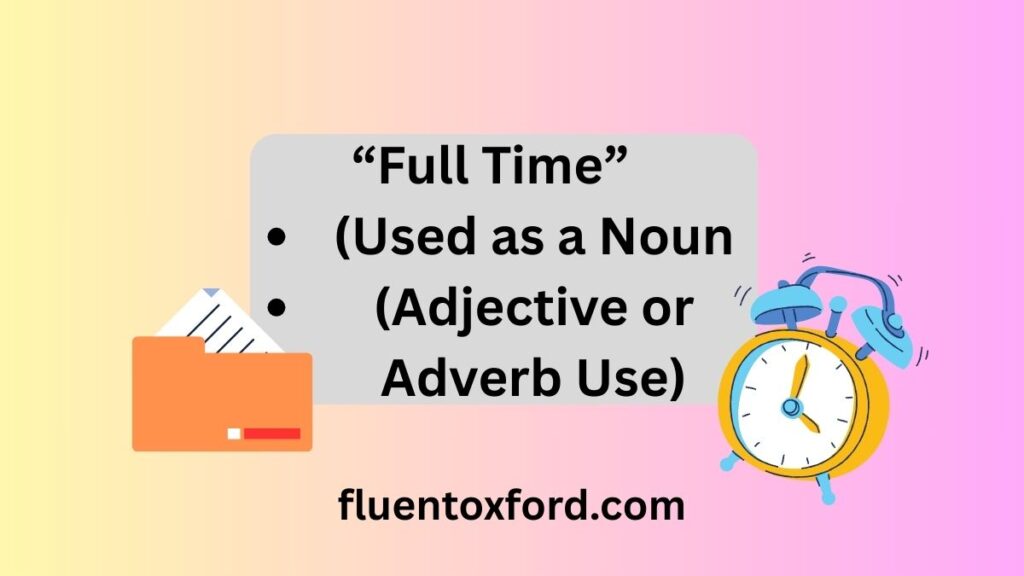The phrase “Full Time or Full-Time: The Right Way” refers to the common confusion between two forms of the same expression—one written as a compound adjective with a hyphen and the other as an open compound noun. In grammar, “full-time” is typically used as an adjective (e.g., full-time job), while “full time” functions as a noun (e.g., working full time). Understanding the distinction is essential for accurate, professional writing, especially in résumés, job descriptions, and academic texts.
In today’s world of digital communication and fast-paced content creation, even the smallest writing errors can affect credibility. That’s why mastering details like the correct usage of “full-time” versus “full time” is more than just grammatical nitpicking—it reflects attention to clarity, professionalism, and style. It’s a simple rule that can leave a lasting impression.
Whether you’re writing a blog post, updating your LinkedIn profile, or editing official documents, knowing “Full Time or Full-Time: The Right Way” can instantly improve your writing precision. By exploring its correct usage, you can avoid common mistakes and communicate with greater authority. Understanding Full Time or Full-Time: The Right Way isn’t just about grammar—it’s about making language work effectively for you.
Why Is There Confusion Between Full Time and Full-Time?
So, which one should you use: full time or full-time?
The confusion stems from the fact that both versions are correct — but they serve different grammatical roles. Understanding when to use each form boils down to basic rules about parts of speech, especially whether you’re using the phrase as a noun or an adjective/adverb.
Another reason people struggle with this is because language tools like Grammarly and Word processors sometimes catch the error — and sometimes don’t. Without consistent correction, bad habits form.
Style guides like the AP Stylebook and the Chicago Manual of Style each provide clear guidelines, but not everyone consults them. That’s where this article comes in — a one-stop source to help you always choose the right version.
What Does “Full Time” Mean? (Used as a Noun)

When “full time” is used as a noun, it refers to a standard measure of employment — generally around 40 hours per week in most workplaces.It often applies to jobs that provide benefits like health insurance or paid leave. When someone says they work full time, they mean they are employed with a standard weekly workload.
✅ Examples:
- She works full time at the hospital.
- After years of freelancing, I finally got a full time gig.
Notice how “full time” is standing alone, functioning as a thing — that is, a noun. You can test this by replacing it with another noun, like employment or a job. The sentence still makes sense.
🧠 Grammar Tip: If the phrase is the subject or object of the sentence, it’s likely a noun and should not be hyphenated.
What Does “Full-Time” Mean? (Adjective or Adverb Use)
Now let’s look at the hyphenated form: full-time. You use this when the phrase is modifying another word — that is, acting as an adjective or adverb. It modifies nouns (e.g., full-time employee) or verbs (e.g., works full-time), indicating a role with complete commitment rather than part-time or freelance arrangements.
✅ Examples:
- She has a full-time job at Google. → Adjective
- He’s employed full-time at the agency. → Adverb
In both cases, “full-time” gives more detail about another part of the sentence — either a noun (job) or a verb (employed).
🧠 Grammar Tip: If you can place a noun immediately after the phrase (like “job”), it’s probably an adjective and should be hyphenated.
How to Know Which One to Use: Simple Rule of Thumb
Here’s an easy way to remember:
| Form | Use | Example | Grammar Role |
| full time | Used as a noun | I work full time. | Noun |
| full-time | Used as an adjective/adverb | She has a full-time position. | Adjective / Adverb |
Just remember: Hyphen = Helper. If “full-time” is helping describe a noun or action, you need the hyphen.
Why It Matters: Real-World Applications
Misusing these terms might seem like a small mistake, but it can cause misunderstandings — or worse, look unprofessional.
🔍 Case Study: Resume Errors
In a recent survey of 1,000 hiring managers, 43% said grammar errors on resumes led to immediate disqualification. Writing “Looking for a full time position” without the hyphen? That could cost you.
📋 Case Study: Job Descriptions
HR teams are expected to write clear job postings. A role labeled as “full time” might leave readers wondering if it’s part-time, contract, or flexible — unless it’s written properly as “full-time role.”
Common Mistakes to Avoid
Here are a few grammar traps people fall into:
- ❌ “I’m looking for a full time.”
→ Sounds incomplete. Needs a noun: “full-time job” - ❌ “She was hired as full-time.”
→ Missing noun. Should be: “as a full-time employee” - ❌ “I’ve worked full-time for years, but I want to go part time.”
→ Inconsistent form. Should be: “go part-time.”
Synonyms for Full Time and Full-Time

You don’t always have to repeat the same phrase. Here are alternatives:
🔤 Synonyms for “Full Time” (Used as a Noun):
- Full employment: Stable, Consistent, Long-term
Example: The country aims to achieve full employment to boost economic stability. - Standard work schedule: Routine, Fixed hours, Regular
Example: Her standard work schedule runs from Monday to Friday, 8 a.m. to 4 p.m. - Career role: Profession, Occupation, Advancement
Example: He finally landed a career role in marketing after years of part-time jobs. - Permanent job: Secure, Ongoing, Commitment
Example: After her internship, she was offered a permanent job at the law firm. - 9-to-5: Office, Daytime, Typical
Example: He prefers a typical 9-to-5 because it gives him evenings free with his family.
📝 Synonyms for “Full-Time” (Adjective or Adverb):
- Salaried: Fixed income, Regular pay, Job security
Example: She accepted a salaried position with benefits and steady income. - Long-term: Extended duration, Permanent, Sustained
Example: He’s looking for a long-term role with growth opportunities. - Year-round: All seasons, Continuous, Non-stop
Example: The resort hires year-round staff to manage operations in all seasons. - Full hours: Full schedule, Complete shifts, Maximized hours
Example: All nurses in the department are employed full hours to cover patient care. - On the clock full shift: Work hours, Active time, Complete duty
Example: He was on the clock full shift from 8 a.m. to 6 p.m. yesterday.
Pro Tip: Avoid overusing “full-time” in the same paragraph. Swap in a synonym to improve readability.
The History Behind the Term
Understanding a word’s origin can give more context — and even improve your memory of the rule.
📚 Etymology of “Full Time”
The term traces back to the early 1900s during the rise of industrialized labor. As work became more structured, “full time” emerged to distinguish workers who had complete commitment to a standard job from those working part-time or hourly gigs.
📕 Etymology of “Full-Time”
The hyphenated version gained traction in the mid-20th century as jobs became more specialized. Descriptive writing — particularly in job ads and corporate documents — needed a clear modifier for roles, hence the adjective “full-time.”
How Style Guides Handle It
Let’s see what major writing authorities say.
| Style Guide | Rule |
| AP Stylebook | Use “full-time” as adjective, “full time” as noun |
| Chicago Manual | Follows traditional hyphenation rules |
| MLA Handbook | Recommends consistent use; notes modifier role |
| Oxford Style Manual | Accepts both; emphasizes clarity in compound modifiers |
No matter which guide you follow, the consensus is clear: use each form based on grammar role.
SEO & Writing Guidance for Content Creators

If you’re a content writer or SEO strategist, the difference between “full time” and “full-time” matters more than you think.
📈 Why It Impacts SEO:
- People search for both: “full-time jobs near me” AND “work full time online”
- Search engines recognize hyphenated vs. non-hyphenated terms differently
- Incorrect usage may reduce content credibility and engagement rates
✅ Quick SEO Tips:
- Include both variations naturally in your content
- Use hyphenated form in headlines and meta descriptions
- Add FAQs with each version to target long-tail keywords
Quick Reference Table
| Usage Type | Correct Form | Example | Grammar Tip |
| Noun | full time | I work full time. | Stands alone as a thing |
| Adjective | full-time | He has a full-time position. | Describes a noun |
| Adverb | full-time | She’s employed full-time. | Describes a verb |
Practical Tools to Help You Catch It
You don’t have to rely on memory alone. Use these language tools to ensure your writing stays sharp:
- Grammarly: Flags hyphenation mistakes.
- Hemingway Editor: Shows complex sentence structure.
- ProWritingAid: Checks grammar and usage in real time.
- Microsoft Word: Built-in grammar checker (but double-check it).
Always proofread — even AI tools sometimes get it wrong
Conclusion
In writing, small choices can make a big difference. The keyword “Full Time or Full-Time: The Right Way” reminds us that knowing when to use a hyphen matters. Use “full-time” as an adjective before a noun, like “full-time job,” and “full time” as a noun, like “He works full time.” This rule is simple but important for clear and correct writing.
Understanding “Full Time or Full-Time: The Right Way” helps you sound more professional. It shows that you care about details. Whether you are writing a resume, an email, or a blog post, getting this right makes your message stronger. Good grammar builds trust and confidence. So, keep this rule in mind and let your writing stand out.
FAQs:
1. Is “full-time” always hyphenated?
No, only when it’s used as an adjective or adverb (e.g., full-time job, working full-time). As a noun, it’s not hyphenated (e.g., He works full time).
2. Should I write “full time” or “full-time” on my resume?
Use “full-time” when describing your position (e.g., full-time role). Use “full time” when talking about your schedule (e.g., works full time).
3. When did “full-time” become standard?
The hyphenated form started becoming standard in the mid-20th century, particularly in formal and professional writing contexts.
4. Does Grammarly catch mistakes with “full time” vs. “full-time”?
Grammarly does catch many of these errors, but always double-check your writing. It may sometimes miss contextual nuances.
5. Can “full-time” be used as a verb?
No, “full-time” is never used as a verb; it’s only used as a noun, adjective, or adverb depending on the context.

As an admin at Fluent Oxford, Maida Queen is the driving force behind our vibrant learning community. With a deep passion for English language education, she ensures that our platform remains a dynamic, engaging, and supportive space for learners worldwide.
Maida expertly manages content, assists users with their grammar and fluency queries, and fosters an interactive environment where learning feels effortless and enjoyable. Whether you need guidance, motivation, or just a friendly face in the Fluent Oxford community, Maida is always there to help you reach your English language goals.








